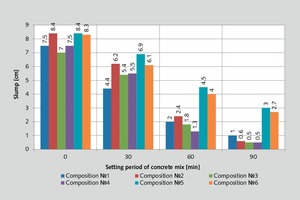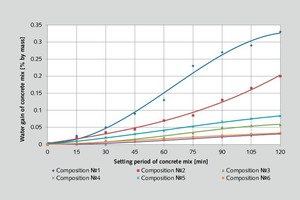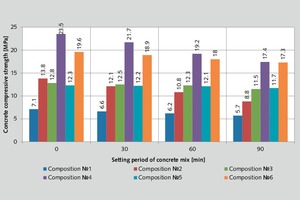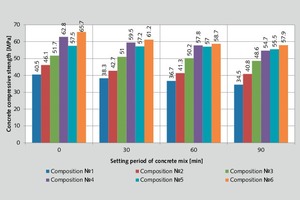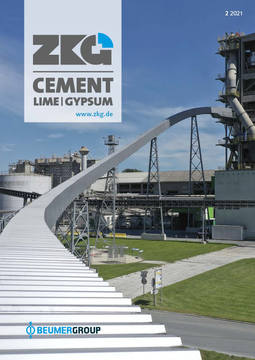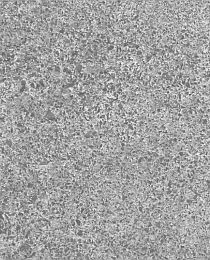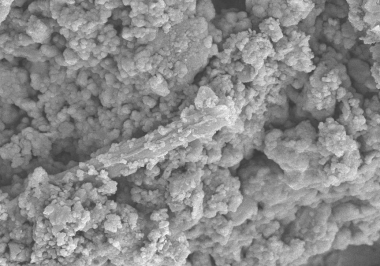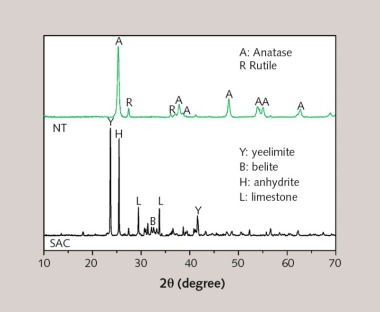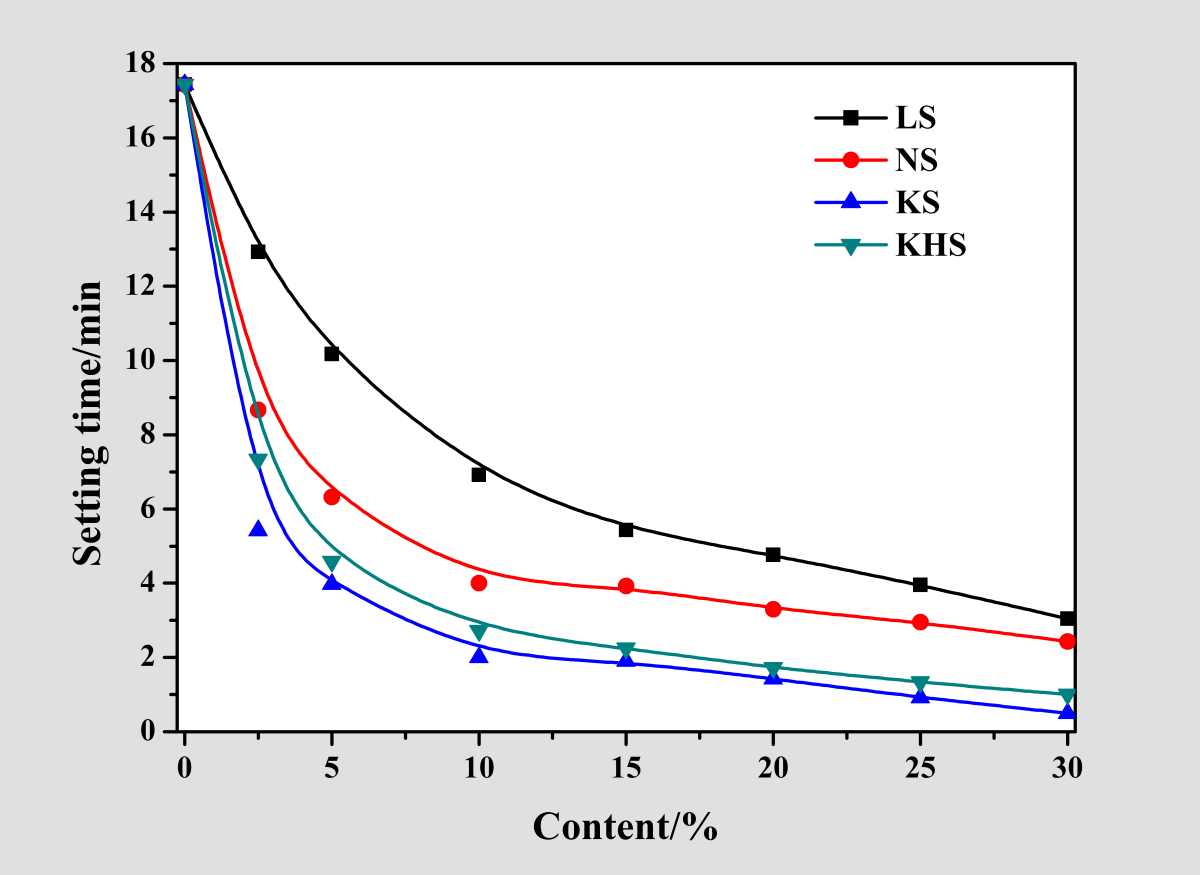Influence of the hydromechanical activation of cement and the setting period of the concrete mix on the properties of high-density concrete
This article examines not only the influence of hydromechanical activation of cement in the presence of superplasticizers on the retention of flowability and the water gain of concrete but also the influence of the setting period of a concrete mix on the compressive strength of high-density concrete at early and late concrete ages. The influence of hydromechanical activation on cement contraction is also examined.
1 Introduction
Transport processes form an intrinsic part of the cast-in-situ construction technology of buildings and structures. The cement hydration processes that take place from the moment that the concrete ingredients are mixed with water and during its transportation to the site have an impact on the rheological properties of the concrete mix and the physico-engineering properties of precast concrete and reinforced concrete structures [1, 2]. The duration of the transportation can therefore lead to significant differences between the properties of the concrete mix prepared at the factory or batching plant and the properties of the concrete mix cast in the formwork at the site.
It should be noted that one of the ways of improving the effectiveness of cast-in-situ building construction technology is to use rapid-hardening concrete. Rapid-hardening concrete has a high strength after the first 3 days of standard curing and can be produced by using high-early-strength cement [3], composite binders [4] and hardening-accelerating admixtures [5, 6], and also by activation of the components of the concrete mix [7-11]. One of the most effective methods of activation in concrete technology is the hydromechanical activation (HMA) of cement.
In this respect the influence of the setting period of a concrete mix on the physico-engineering properties of rapid-hardening concrete is a very interesting subject for research. In this paper the setting period was taken to be the period from the end of mixing of the concrete to its casting.
The effectiveness of the application of HMA (hydromechanical activation) to cement in cast-in-situ construction technology is described in [12, 13], including combined application with the introduction of superplasticizers to the mix. Its effectiveness is assessed by the substantial increase in the concrete compressive strength at an early age. It should be noted that HMA of cement must not be accompanied by a rapid loss of slump of the concrete mix. For example, concrete mixes with the same flowability that have been modified with a superplasticizer based on naphthalene formaldehyde compounds lose flowability more rapidly than concrete mixes modified with admixtures based on lignosulfonates and polyoxycarboxylic acids [14]. The slump loss of a concrete mix is mainly governed by the effect of the water-cement ratio on its hydration and structure formation processes. This also applies to mixes based on mixed binders [15].
A concrete mix is a multicomponent system in which the sedimentation processes from the time when the concrete is mixed to the time when it sets are governed by the different densities of the components. Water gain may be observed during this period. Concrete mixes modified with superplasticizers have greater concrete mix cohesion and less water gain than unmodified, easily workable, mixes. The reason for this is the lower water gain of the plasticized mixes, which depends in turn on the superplasticizer content, mix proportions and cement content [14]. This means that there is great interest in the research into the influence of HMA of cement containing superplasticizers on the technological properties of a concrete mix.
The present paper focuses on the research into the influence of HMA of cement containing superplasticizers and of the setting period of the concrete mix on the technological properties and physico-engineering properties of high-density concrete.
2 Materials and methods
The following raw materials were used for the concrete mix:
binder: Portland- slag cement CEM II/A-W 32.5H produced at the Ul‘ianovskiy plant as per GOST 31108-2016
fine aggregate: sand from the Kamsko-Ust‘inskoe mineral deposits with a fineness modulus of 2.7 as per GOST 8736-2014
coarse aggregate: granite chippings from the Urals mineral deposits with a size of 5-20 mm as per GOST 8269.0-97
The above-mentioned components were used in the concrete mix in the following quantities: Portland-slag cement – 490 kg/m3, sand – 595 kg/m3, granite chippings – 1140 kg/m3. Different superplasticizers were used to decrease the water gain of the concrete mix and improve the effectiveness of dispersion of cement particles in an aqueous medium [16, 17]:
“Relamix T-2” superplasticizer produced by Poliplast Ltd as per technical conditions 5870-002-14153664-04, based on the sodium salts of polymethylene naphthalene sulfonic acids with the addition of a complex that accelerates concrete strength development;
“Remicrete SP60” superplasticizer produced by the “Schomburg” company (certification number 0764-CPD-0012) - a copolymer based on polyether carboxylates
A rotor-pulse-coupled aggregate (RPCA) RPA-0.8-55A-2.2-UZ produced by Promservice Ltd as per technical conditions 5132-001-70447062 was used in the present paper as the method of producing rapid-hardening concrete by HMA (hydro-mechanical activation) of the cement, including the introduction of superplasticizer. 50% of the cement required for the preparation of a concrete composition was mixed with the gauging water containing the superplasticizer. The final suspension was submitted to HMA in the RPCA for 2 min. It was then placed in the concrete mixer and mixed with the rest of the cement (50%) and the concrete fillers for 5 min.
Six concrete compositions were prepared for the experimental investigations:
composition No. 1 – reference concrete composition prepared by mixing the raw components in a concrete mixer (without superplasticizer)
composition No. 2 – rapid-hardening concrete mix prepared by HMA of the cement (without superplasticizer)
composition No. 3 – concrete mix composition modified with “Relamix T-2” at a concentration of 1% by mass of cement, prepared by mixing the raw components in a concrete mixer
composition No. 4 – rapid-hardening concrete mix modified with “Relamix T-2” superplasticizer at a concentration of 1% by mass of cement, prepared by HMA of the cement
composition No. 5 – concrete mix composition modified with “Remicrete SP60” superplasticizer at a concentration of 1% by mass of cement, prepared by mixing the raw components in a concrete mixer
composition No. 6 – rapid-hardening concrete mix modified with “Remicrete SP60” superplasticizer at a concentration of 1% by mass of cement, prepared by HMA of the cement
The quantity of gauging water was chosen to achieve concretes of equal flowability – grade P2 as per GOST 7473-2010. The water gain of the concrete mix and the retention of flowability were measured as per GOST 10181-2014. The parameters of the concrete mix were first measured immediately after mixing; further measurements were taken at 30 min intervals. The compressive strength characteristics of the high-density concrete were determined as per GOST 10180-2012. Cement shrinkage was determined in accordance with the MI 2486-98and MI 2487-98 measuring techniques using the “Cement-Prognoz” contractiometric cement activity tester.
3 The influence of HMA of cement on the technological properties of a concrete mix
The results of research into the influence of HMA on the retention of flowability of concrete mixes are shown in Figure 1.
Analysis of the results obtained (Figure 1) indicates that the flowability of compositions No. 1-4 with a setting period of 90 min decreases by 85-92%. The flowability of compositions 5 and 6 is reduced more slowly with the result that when the concrete mix has a setting period of 90 min the slump decreases by 60-70%. The research results given in the papers [14, 18, 19] demonstrate the effect of sustained retention of the flowability of concrete mixes with the introduction of polycarboxylate superplasticizer admixtures when compared with admixtures based on sulfonaphthalenic formaldehydes, sulfomelanines and lignosulfonates.
The relationships between the water gain of a concrete mix and the setting time are shown in Figure 2.
The data from Figure 2 shows that the highest water gain occurs with composition No. 1 and it is equal to 0.33-0.42% by mass of concrete mix. HMA of cement (composition No. 2) helps to reduce the water gain by a factor of 1.5-1.9 when compared with the reference sample. Introduction of superplasticizers to the concrete mix (composition No. 3 and No. 5) helps to reduce the water gain by a factor of 5-7.
The best performance of the concrete mix from the aspect of water gain is observed with compositions No. 4 and No. 6 produced by HMA of the cement together with the use of superplasticizers. During HMA of cement in the presence of the “Relamix T-2” admixture (composition No. 4) the water gain of the concrete mix is reduced by a factor of 2-4 when compared with the composition that is not subjected to HMA (composition No. 3). The lowest water gain of the concrete mixes is observed with composition No. 6 produced by HMA of the cement in the presence of the “Remicrete SP60” admixture and amounts to 0.02-0.05% by mass of concrete mix. This is lower than with the composition that has not been subjected to HMA (composition No. 5) by a factor of 3-5.
The reduction in water gain of concrete mixes produced with HMA of the cement is related to the high water consumption for binder hydration owing to its increased specific surface area.
4 Influence of HMA of the cement on the physico-engineering properties of high-density concrete
The next step was to study the influence of HMA of the cement and of the setting period of the concrete mix on the compressive strength of high-density concrete at 1 and 28 days. The results of the experimental investigation are shown in the Figures 3 and 4.
The data listed in Figures 3 and 4 show a decrease in the compressive strength of high-density concrete samples with increasing setting period of the concrete mix. For example, the compressive strength of the samples cast with concrete mix composition No. 2 is reduced by 36% at 1 day and by 11% at 28 days when the concrete mix has a setting period of 90 min. This is thought to be due to destructive processes in the crystalline lattice of the hardened cement paste formed due to the accelerated structure formation process during cement activation and in the casting and compaction processes of the concrete mix.
Application of superplasticizers “Relamix T-2” (composition No. 3) or “Remicrete SP60” (composition No. 5) makes it possible to save the potential compressive strengths of the samples of the concrete mixes with a setting period of 90 min. For example, the compressive strength of the samples cast from the concrete mix with composition No. 3 is reduced by 10% at 1 day and by 6 % at 28 d when the concrete mix has a setting period of 90 min.
Comparison of the compressive strength of modified high-density concrete samples prepared by HMA of the cement with that of samples prepared by traditional mixing of the raw components in a concrete mixer is of scientific and practical interest. This shows that the compressive strength of the samples of concrete mix of composition No. 4 at 1 day is 84% higher than the compressive strength of the samples of concrete mix of composition No. 3 when they are cast after the concrete is mixed and by 51% when the setting period is 90 min. At 28 d the ultimate compressive strength of the samples of concrete mix of composition No. 4 exceeds the compressive strength of concrete mix of composition No. 3 by 21% when they are cast after the concrete mixing and by 13% when the setting period is 90 min. The compressive strength of the samples of concrete mix of composition No. 6 at 1 day is higher than the compressive strength of concrete mix of composition No. 5 by 59% and by 48% when the setting period is 90 min. The compressive strength of the samples of concrete mix of composition No. 6 at 28 d exceeds the compressive strength of concrete mix of composition No. 5 by 14% when they are cast after the concrete mixing but only minor changes in compressive strength can be observed with a setting period of 90 min.
The results achieved can be summarized by concluding that it is more beneficial to apply HMA of cement in the presence of superplasticizer “Relamix T-2” based on naphthalene formaldehyde because when “Remicrete SP60” admixture is used there is only an increase in the early concrete strength while the 28 d strength increases slightly.
The next step was to study the influence of HMA on cement contraction. The experimental results are shown in Figure 5.
The data shown in Figure 5 show an increase in contraction of cement exposed to HMA (composition No. 2) by a factor of 1.7 after 8 hours when compared with composition No. 1. HMA of cement with “Remicrete SP60” admixture (composition No. 6) leads to an increase in cement contraction by a factor of 1.8 after 8 hours of hydration in comparison with composition No.1 and by a factor of 1.7 in comparison with composition No. 5.
HMA of cement in the presence of “Relamix T-2” admixture (composition No. 4) gives the highest value of cement contraction of the compositions under consideration. For example, there is increase of contraction by a factor of 2.7 after 8 hours of hydration when compared with the reference sample (composition No. 1) and by a factor of 3.2 when compared with composition No. 3. The results obtained show an intensification of the cement hydration processes of the samples exposed to HMA.
5 Conclusions
1. It was found that the best performance from the aspect of retention of flowability of the concrete mix is observed in the compositions modified with superplasticizer “Remicrete SP60”. The slump decreases by 60-70% when the concrete mixes have a setting period of 90 min (compositions No. 5 and 6).
2. It was found that that lowest water gain of the concrete mix is observed in composition No. 6 prepared by HMA of cement in the presence of “Remicrete SP60” admixture and amounts to 0.02-0.05% by mass of concrete mix. This is lower by a factor of 3-5 when compared with the composition that has not been exposed to HMA (composition No. 5). This is due to the high water consumption for binder hydration as result of the increase in its specific surface area during activation.
3. It was found that the greatest effectiveness from the aspect of the increase in compressive strength is observed with HMA of the cement in the presence of “Relamix T-2” superplasticizer (composition No. 4) based on naphthalene formaldehyde. This helps to increase the compressive concrete strength by 51% at 1 day and by 13% at 28 days age when compared with the composition that has not been exposed to HMA.
4. It was found that HMA of the cement, including in the presence of superplasticizers, increases the contraction of cement significantly. The best performance is achieved with HMA of cement in the presence of “Relamix T-2” admixture (composition No. 4). This increases the contraction of cement by a factor of 3.2 after 8 hours of hydration when compared with composition No. 3. This indicates an intensification of the cement hydration processes in the sample that has been exposed to HMA.
5. The results obtained show the effectiveness and benefits of the application of HMA of cement in cast-in-situ construction.
6. A study of the influence of HMA of cement, including in the presence of chemical admixtures, on the special features of hydration and structure formation of high-density concrete will be of substantial interest for further investigations.
pp. 29-40

